
The mid-size truck market has been such a conundrum for the “Big 3,” that GM, Ford and Ram simply packed up and left it behind a few years ago. With no Canyons/Colorados, no Rangers and no Dakotas to contend with, Toyota and Nissan have battled for supremacy in what amounts to a forsaken class, with the Toyota Tacoma usurping nearly 67 percent of the roughly 250,000-unit mid-sized truck market each year. Put into perspective, that’s only a tad more volume than total sales of the Chevrolet Silverado Series alone.
With that in mind, GM’s decision to re-enter the mid-sized segment in 2015 is kind of curious. Add the fact that the company’s all-new mid-sized truck platform, shared across the Chevy and GMC lines, uses the same names as its less-than-successful previous mid-sized offerings, and one can’t help but raise the question, “Why now?”
The answer, GM officials tell us, is simple: Opportunity.
With no major updates to the Toyota Tacoma or Nissan Frontier in nearly 10 years, the mid-sized segment is ripe and ready for some fresh produce. Ford has made it clear that it intends to focus its efforts on the F-150 by offering enough engine and trim options to satisfy the masses with its half-ton truck. Ram hasn’t sent any obvious signals that it intends to re-enter the mid-size market either way. Toyota and Nissan? Well, let’s just say that maybe the lack of competition from their American rivals has made them a little complacent. Neither of the Japanese stalwarts has made much noise about their future in the class. Thus, it makes some sense that GM figured now is the time is right to strike with all-new mid-sized trucks even if they wear recycled model names, the Chevrolet Colorado and GMC Canyon.
Get the Flash Player to see this player. |
Still, a lot of questions remain: How will the new Colorado and Canyon differentiate themselves from the rest of the class, and will they possess enough of a wow factor to erase the blandness of their predecessors? Will they hold the right combination of performance and affordability to make them an attractive alternative to half-ton pickups?
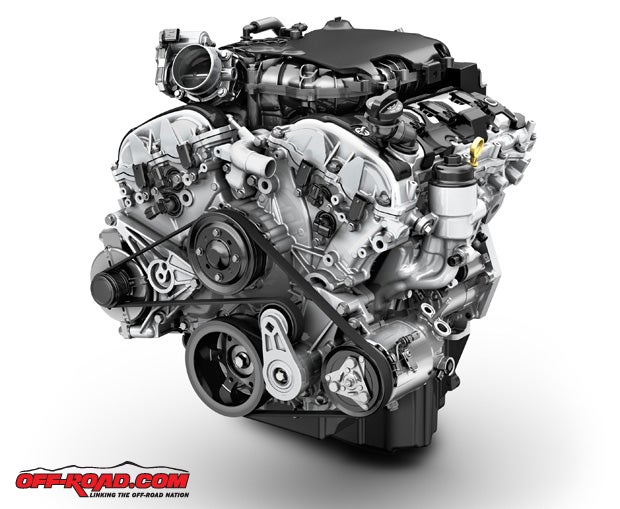
GM responded to these questions and more during our recent press launch event in Del Mar, California, and their answers are pretty straightforward. The mid-sized truck market is one of the most dissatisfying among all truck owners, who cite poor fuel economy, a lack of interior refinement, and overall noisy ride quality among the current class contenders. In all fairness, GM would probably have to admit that its own previous offerings weren’t up to snuff either. They feel very differently about the 2015 Colorados and Canyons.
The Same, But Different
Available in both 2WD and 4WD options, the 2015 Chevy Colorado and GMC Canyon are, of course, built on the same platform, but they will have different identities by virtue of their interior and exterior styling. The single-cab options are gone entirely, with both trucks offered only in Extended Cab or Crew Cab version. Their fully boxed steel frame is described by GM as basically a shortened Silverado/Sierra design. The Extended Cab models feature a 6’2” bed, while the Crew Cabs will have the option of a 5’2” or a 6’2” bed. Also, depending upon the model, the payload capacities vary from 1410 to 1590 pounds – big numbers for a mid-sized truck.
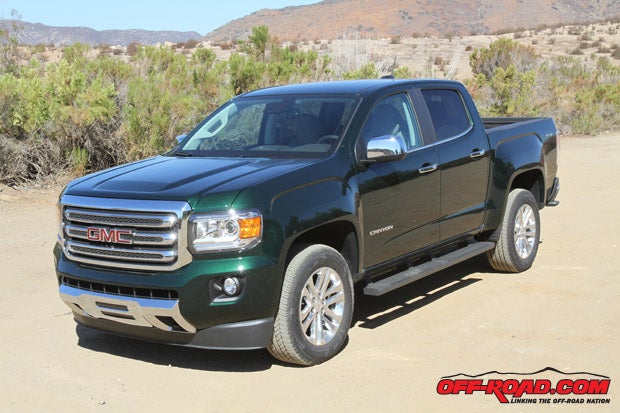
Two engine options power the Colorado and Canyon: a 2.5-liter DOHC inline four-cylinder, and a 3.6-liter VVT DI V6. The 150 cubic-inch four-cylinder motor features a cast-aluminum block and head, producing 200 horsepower at 6300 rpm and 191 lb.-ft. of torque at 4400 rpm. The 3.6-liter V6 also features a cast aluminum block and head, but the 217cubic-inch motor pumps out a class-leading 305 hp at 6800 rpm and 269 lb.-ft. of torque at 4000 rpm.
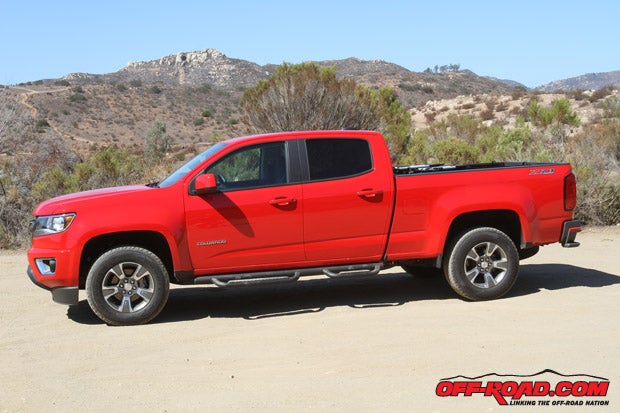
Good fuel economy is arguably one of the most important issues in this class, however, and both powertrains attempt to address it. The V6 checks in with an EPA-estimated 18 mpg city/26 mpg highway for the 2WD model, while the 4WD models dip to 17 mpg city/24 mpg highway. The 2.5-liter motor offers a little more, with an EPA-estimated 20 mpg city/27 mpg highway rating.
The platform’s front suspension uses an independent coilover design that features twin-tube shocks, stamped steel control arms, cast-aluminum steering knuckles and larger-diameter, hollow steel stabilizer bars. Out back is a Hotchkiss-type live rear axle that uses two-stage multi-leaf springs designed to provide a balance between smooth handling and hauling capacity. Just like the front, twin-tube shocks are utilized on each rear corner. An automatic locking rear differential is standard equipment on the Z71 trim package and it’s an option on the WT and LT trims. The Base and WT trims also feature 16 x 7-inch steel or aluminum wheels, while the LT and Z71 offer extra wheel options, including 17 x 8-inch or 18 x 8.5-inch aluminum wheels.
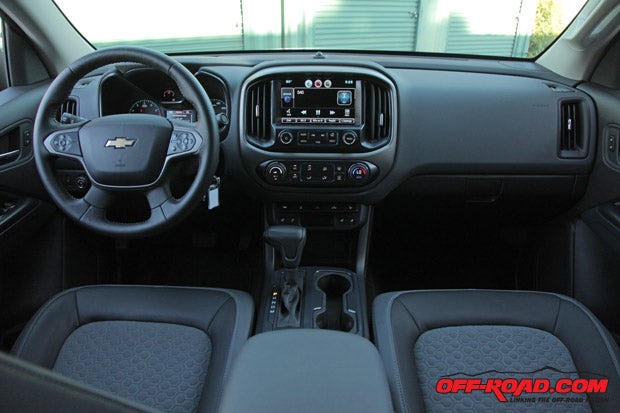
Breaking Out of the Pack
To separate itself from its competition, GM really sought to provide some added features and benefits on the Colorado and Canyon not currently found in the market sector. The first, and most obvious, is in the interior, which includes a large, 8-inch touchscreen display that is available in every truck from the mid-trim level models on up. The touchscreen system offers Bluetooth phone pairing, gesture recognition options, natural voice recognition and optional navigation, among other features.
What may be most noticeable about the 8-inch touchscreen is how seamlessly it fits into the redesigned dash, which is ergonomically and aesthetically one of the nicest aspects of the Colorado/Canyon. The air conditioning controls are cleanly segregated from the stereo/touchscreen section, and a piano-key-style switchboard below the A/C controls functions such as the tow-haul mode, stability control, hazard lights and more.
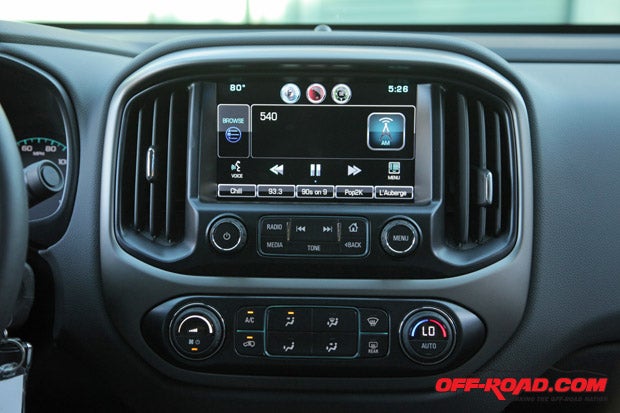
Another unique feature is that the truck can be used as a WiFi hotspot via the OnStar 4G LTE system. The hotspot can connect up to seven tablets, laptops or phones and the range is up to 50 feet around the vehicle. GM says the OnStar provides a much stronger signal than a smartphone.
A number of exterior upgrades also add storage versatility to the platform. GM’s new GearOn Accessories System is designed to make even better use of bed space, by providing the option for two-tier loading for hauling larger items (bikes, kayaks, paddleboards, etc.) on utility rack stanchions while retaining the truck bed for storage space. The bed itself also features four permanent tie-down locations.
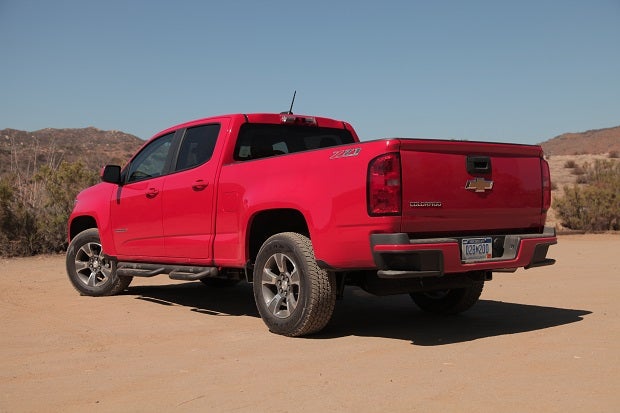
Another key upgrade touted by GM, especially compared to the trucks currently available, is a class-exclusive damped EZ Lift and Lower tailgate, a feature traditionally found only on some half-ton trucks. A CornerStep rear bumper also offers easy access to the truck bed for loading and unloading.


 Your Privacy Choices
Your Privacy Choices